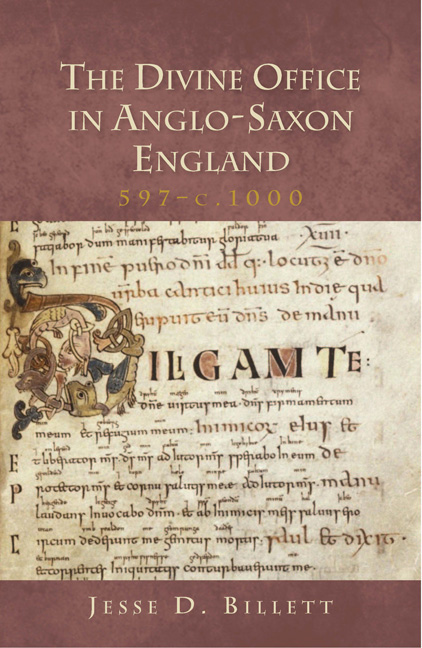Book contents
- Frontmatter
- Dedication
- Contents
- TABLES
- ILLUSTRATIONS
- PREFACE
- NOTE ON USAGE
- ABBREVIATIONS
- MANUSCRIPT SIGLA
- Part I The Historical Development of the Divine Office in England to c.1000
- Part II Manuscript Evidence for English Office Chant in the Tenth Century
- 6 A METHODOLOGY FOR THE STUDY OF ANGLO-SAXON CHANT BOOKS FOR THE OFFICE
- 7 TWO WITNESSES TO THE CHANT OF THE SECULAR OFFICE IN ENGLAND IN THE TENTH CENTURY
- 8 A FRAGMENT OF A TENTH-CENTURY ENGLISH BENEDICTINE ‘BREVIARY’
- 9 A FRAGMENT OF A TENTH-CENTURY ENGLISH BENEDICTINE CHANT BOOK
- 10 CONCLUSION: WAYS OF MAKING A BENEDICTINE OFFICE
- Appendices
- BIBLIOGRAPHY
- INDEX OF MANUSCRIPTS
- INDEX OF LITURGICAL FORMS
- INDEX OF BIBLICAL REFERENCES AND LITURGICAL READINGS
- GENERAL INDEX
10 - CONCLUSION: WAYS OF MAKING A BENEDICTINE OFFICE
from Part II - Manuscript Evidence for English Office Chant in the Tenth Century
Published online by Cambridge University Press: 05 November 2014
- Frontmatter
- Dedication
- Contents
- TABLES
- ILLUSTRATIONS
- PREFACE
- NOTE ON USAGE
- ABBREVIATIONS
- MANUSCRIPT SIGLA
- Part I The Historical Development of the Divine Office in England to c.1000
- Part II Manuscript Evidence for English Office Chant in the Tenth Century
- 6 A METHODOLOGY FOR THE STUDY OF ANGLO-SAXON CHANT BOOKS FOR THE OFFICE
- 7 TWO WITNESSES TO THE CHANT OF THE SECULAR OFFICE IN ENGLAND IN THE TENTH CENTURY
- 8 A FRAGMENT OF A TENTH-CENTURY ENGLISH BENEDICTINE ‘BREVIARY’
- 9 A FRAGMENT OF A TENTH-CENTURY ENGLISH BENEDICTINE CHANT BOOK
- 10 CONCLUSION: WAYS OF MAKING A BENEDICTINE OFFICE
- Appendices
- BIBLIOGRAPHY
- INDEX OF MANUSCRIPTS
- INDEX OF LITURGICAL FORMS
- INDEX OF BIBLICAL REFERENCES AND LITURGICAL READINGS
- GENERAL INDEX
Summary
It is now possible to offer some answers to the questions posed at the end of Chapter 5, and to reconstruct the process whereby the ninth-century Frankish concept of a distinctive ‘monastic’ Office based on the Rule of St Benedict was put into practice in England in the tenth century. The two extant fragments from tenth-century English Benedictine Office books reveal two very different approaches to the creation of a Benedictine Office liturgy. In the breviary fragment in BL Royal 17. C. XVII (Roy), an Office antiphoner of Corbie was the source for the texts of the chants and their arrangement. We are probably dealing here with a minster reformed through Æthelwold's influence. Traces of Corbie ordines in several later medieval English Benedictine breviaries reveal that Æthelwold's approach was widely imitated. The advantages of adopting wholesale a Continental Benedictine antiphoner will have been obvious to any reforming abbot: not only would appropriate antiphons and responsories be made immediately available, but their arrangement would provide a ready-made framework around which to construct a fully Benedictine Office, with the antiphons automatically requiring the Benedictine distribution of the psalms, and the responsories in the festal and Sunday Night Offices demanding the monastic twelve lessons in place of the secular nine.
- Type
- Chapter
- Information
- The Divine Office in Anglo-Saxon England, 597-c.1000 , pp. 348 - 352Publisher: Boydell & BrewerPrint publication year: 2014



